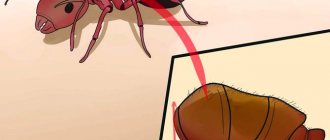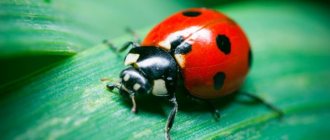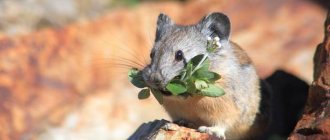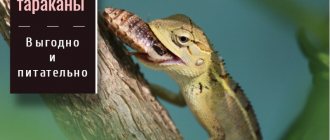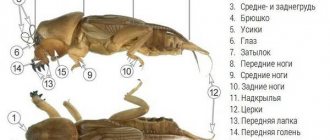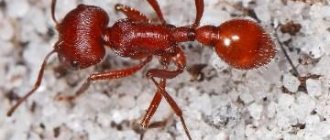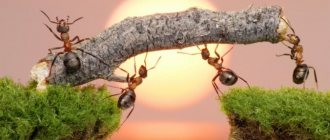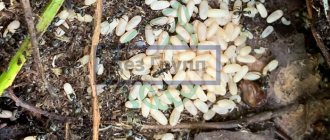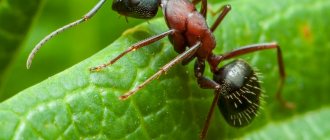Description and appearance
Ants live mainly by smells, which allow them to determine not only their relatives, but also the place where the food is located. Insects are able to secrete formic acid to protect themselves from enemies in nature. They bite and it hurts quite a lot.
Larvae
Ant larvae hatch from eggs laid by queens. At first they are the same size as the eggs themselves - approximately 1 mm. The eggs are white or yellowish in color with a blue or gray tint and a very delicate covering.
Depending on the specific species and genus, the sizes and shapes of the larvae have characteristic differences.
They are covered with fine hairs, which protect them from damage or sticking together, which can happen when constantly carried by nurse ants. The larva goes through several stages and gradually fattens. Over time, it increases in size and turns into a pupa.
Adults (imago)
The body of an adult individual consists of three main parts, which are rarely separated from each other and are covered with a unique chitinous shell. They are connected by a waist - a kind of thin jumper.
The main parts of the insect's body:
- head;
- breast;
- abdomen.
The main features of the body structure and appearance of an adult ant:
- The compound eye consists of a huge number of lenses, but does not produce a high-quality image, but only allows it to react to movement. There are also three simple eyes on the top of the head.
- There are six legs, at the end of which there are thin claws, thanks to which insects can move along horizontal or vertical planes.
- There are thin antennae on the head that act as an organ of touch. They allow the insect to catch different odors and respond to air and soil vibrations.
- Females grow wings, but they disappear after fertilization.
- Body color can be very different and differs depending on the specific species.
The size of an ant directly depends on the variety and functions that are clearly defined for each member of the colony. On average, their size ranges from 1 mm to 4 cm.
The size of female insects is significantly larger than the size of worker insects.
Lifespan of some ant species
Pharaoh ants live shorter than others.
It is easy to guess from the name that their homeland is the hot countries of Africa. How do ants of this species live in very cool Europe? They settle next to a person. They do not build anthills; they arrange their nests in the cavities of residential buildings. It doesn’t matter whether they are wooden or concrete multi-story ones. Female pharaoh ants rarely live to an advanced age, usually not reaching a year
But they are distinguished by high fertility - in 12 months they are capable of producing several thousand individuals. Moreover, several “queens” can simultaneously coexist in the nests of pharaoh ants. Males of this species live only 20 days, worker ants - about two months.
Black garden ants also live not far from humans. They need human housing to survive the winter. Garden ant workers can live up to 3 years. Tropical ants live the longest. There is a known case where the queen of a bulldog ant lived for 28 years. But even ordinary, working ants of this species live up to 5 years.
Also, familiar to us firsthand, is the harvester ant, five of the 110 species of which live in Russia. They live in colonies of up to 5,000 individuals. These ants are perhaps the most popular species for breeding in home anthill farms - formicariums. How long do harvester ants live? Their life span consists of several stages:
- Egg 2-3 weeks
- Larva 2-3 weeks
- Cupola 2-3 weeks
- And a full-fledged worker ant that has already appeared after 1.5 - 2 months will live from 1 to 5 years, depending on living conditions. But the queen of the harvester ant (aka queen) can live up to 20 years.
When living in a formicarium in an apartment, the lifespan of an ant is reduced many times over.
Previous entry How to remove bedbugs: only proven methods in the fight against dangerous insects Next entry
Types of ants
Today there are a huge number of species of these insects. Some of them are so similar to each other that only a specialist can determine exactly what genus this representative is. Let's look at the types of ants that most often live in our latitudes.
Forest
The forest variety prefers forests where a temperate climate prevails. This species is widespread throughout the Euro-Asian continent.
Main characteristics of forest inhabitants:
- Red-brown body color, reddish cheeks, black belly.
- They reach from 7 to 15 mm in length.
- In forests they build large nests, which can be up to 2 m in height. Branches with pine needles are used as building material.
The species is listed as endangered. Rare in some regions.
Meadow
The species is highly resistant to cold. Meadow ants prefer forest areas in the temperate latitudes of Eurasia (almost the entire territory of Europe, most of the Russian Federation).
Main characteristics of meadow ants:
- The color is red, there is a black spot on the chest, the body is covered with elastic hairs, but they are absent in females.
- They grow from 6 to 13 mm in length.
- They prefer to settle on the edges, meadows and clearings. The anthill is loose, with a diameter of about 3 m at the base. The dome looks like a slightly flattened cone. Large plant remains sprinkled with sand are used as construction material.
- Up to 70,000 insects live in one nest.
Garden
Black garden ants are the most common species in the Russian Federation. These insects are considered pests, as they can breed aphids and scale insects on garden crops.
Main characteristics of black garden ants:
- The body can be black or dark brown. The top of the body is covered with small hairs.
- Working individuals grow from 3 to 6 mm, females - up to 1 cm.
- Anthills are located underground. The part located on the surface looks like a small mound. This species also lives under large stones or in old wood.
- There are 70,000 individuals in the family and only one queen. The lifespan of the uterus is 30 years.
Earthen
This is the most common species in the middle zone. Earth ants differ from their counterparts in their small size. “Kids” are found almost everywhere.
Main characteristics of earth ants:
- The color is black or dark brown.
- Working individuals are very small – from 3 to 6 mm. Females reach a length of 6 mm to 1 cm.
- The nest is formed in the ground and gradually grows upward in the shape of a hummock. At the very top of the head there is a solarium, necessary for brood.
Earth ants are very aggressive and may attack other species to defend their territory.
Brownies
House or pharaoh ants are found throughout Russia. It was originally a tropical species that spread throughout the world in the 19th century. Insects traveled on ships from India and populated the entire planet.
Main characteristics of house ants:
- The insects are yellow-brown or red in color, with a dark abdomen. The uterus has tan marks that have a dark brown tint. Males always have wings.
- Insects differ from their counterparts in their small sizes - from 1 to 4 mm. The uterus can grow up to 6 mm.
- This species does not have a familiar anthill. Insects live in diffuse nests. Getting rid of pests is very difficult.
- This species loves warmth, so it often settles in human homes. Insects prefer to live between the walls of houses, in dark cracks or crevices, and settle behind wallpaper or inside equipment.
One family includes several thousand insects. Moreover, in one anthill there can be about 200 females. There are also large colonies - up to 300 thousand individuals.
Where and how do ants live
All ants live in constructed anthills or nests that are connected to the ground, and in some cases these insects can be found under stones or in wood. In one nest the number of these insects reaches a million individuals. As was said earlier, in every ant nest there is always a queen, who under no circumstances leaves it.
Ants often live in anthills
Since ants are predators, their diet consists of larvae or caterpillars, as well as flowering vegetation and milking of aphids.
A distinctive feature of these insects is that all individuals that live in the same nest have the same smell. This allows them to recognize each other in the first place, and also prevent other ants from entering their home.
These insects communicate with each other using special signals, such as, for example, touching their antennae, head or legs. In addition to this, they also use special chemical signals. For example, if an ant is disturbed, then in such a situation it will rise on its hind legs and tilt its abdomen slightly forward.
Life of ants
Due to the huge number of species, the life of these insects has a direct impact on biogenesis. By forming anthills, they intensively loosen the soil, the roots of the plants are saturated with moisture and oxygen. At the same time, ants nourish the soil with various useful substances.
Diet
Each type of ant has its own feeding characteristics, so it is simply impossible to single out specific food. Insects feed on food items of animal or plant origin.
For proper development of larvae, protein is needed, the main source of which is dead insects, the remains of various animals and partially digested food left over from the imago.
House ants feed on gelatin, various dairy products, or leftovers from egg dishes. The queen eats protein food supplied by the individuals who care for her. Carbohydrates are obtained from honeydew and the fluid secreted by aphids.
Ants are capable of forming large farms from aphids. Then they “graze” them and guarantee protection from other inhabitants. Thus, the ants independently provide themselves with food. Read more about what ants eat here.
What does the ant “menu” in nature consist of:
- Nuts, seeds and juices of green plants are the basis of the diet.
- Some species breed entire colonies of mushrooms in their own nests.
- Various insects with caterpillars are also included in the diet.
- The menu of harvester ants includes dry fruits, various seeds, and grain crops. About a kilogram of nutritious food is prepared for the winter period - this is enough for the whole family.
- Leaf-cutter ants feed on leaves, storing them for the winter. The leaves are chewed and stored in this form in special chambers. After some time, mushrooms appear on them, which become food for the whole family.
- House ants are omnivores and can easily profit from a variety of foods, including food waste.
When it gets very cold, insects hibernate and stop feeding completely. But there are species that continue to lead an active life in winter, surviving on reserves made in the summer.
How does the reproduction process occur?
Reproduction occurs 2 times a year in two different ways:
- The female leaves her family, taking several workers. She then forms a new family.
- The female goes on a mating flight, where she is fertilized by males living in another anthill. After fertilization, the female lays eggs, and when they mature, a group of worker ants is formed. While waiting for new workers to mature, the queen feeds on the remains of her own wings.
Read more about how ants reproduce in our next article.
Insect development
Ants go through several stages of development - an egg, from which a larva hatches, and a pupa, which turns into an imago or adult. The queen mates only once in her entire life. The sperm obtained from the male is used by the female throughout the entire period.
Stages of ant development:
- The queen lays eggs, from which larvae emerge. Since they practically do not move, workers are responsible for their nutrition. There are four stages of molting, after which the larva stops feeding.
- By excreting the contents of its own intestines, it becomes a pupa.
- After completing the pupal stage, other individuals help the former larva emerge from the cocoon, since the young ant cannot do this on its own.
You can see how an ant develops in the following video:
Where do they live?
Ants are found on all continents. Insects live in different climatic zones. They are found not only in mid-latitudes, but also in deserts, as well as Antarctica and the Arctic.
Often ant nests can be found in the ground, rotten wood, under various objects that lie on the soil. There are species that do not build homes, preferring to attack and capture others.
There are species that prefer living next to humans - for example, in a garden or house.
Construction of an anthill
Most species are engaged in the construction of complex and large nests, but there are also those who lead a nomadic lifestyle and do not organize permanent housing. There are both underground anthills and tree houses.
During construction, soil, plant matter that is carefully selected, and many other “building” materials are used. Complex nests necessarily consist of a structure that ensures constant and optimal ventilation, air humidity and other important indicators.
You can see how ants build an anthill in the following video:
How does an ant colony work?
The social hierarchy within an ant colony is often compared to the structure of a bee hive. These two species are similar in many ways, but the behavior of ants is still much more complex. Just like in human society, these insects have a strict division into classes. The anthill is designed in such a way that each mature individual has its own purpose.
Depending on a set of certain qualities, each insect is assigned to one or another social post. In this case, the personal qualities of the individual are taken into account - excessive aggressiveness, keen sense of smell, reaction speed. The hierarchy of any anthill contains the following categories of individuals:
- invaders - the most aggressive group in the anthill, attacks neighboring colonies, seizes territories,
- orderlies - isolate sick and wounded ants, if necessary, play the role of surgeons - the damaged limb is often amputated (gnawed off),
- builders are one of the largest social groups. They are engaged in repairs of premises and the external covering of the home. Throughout their life, they dig new tunnels, transport needles and twigs, maintain the microclimate inside the anthill,
- nannies - take care of the offspring, from the appearance of the egg to the adulthood of the individual. They are constantly close to the larvae, turn them over, control the process of hatching from eggs and feed the growing offspring,
- guards - are engaged in guarding the entrances and exits of the anthill; in the event of an attack, they attack the enemy and do not allow him to get inside the dwelling. Among this category there are the most losses; attacks on neighbors are common for neighboring colonies. In addition, birds and some animals like to feast on ants, and the guards never leave their posts, protecting the entrance to the last.
- foragers. The largest group in the colony. Their mission is to obtain food for the entire anthill. Every day, miners go in search of food - grass seeds, dead and weakened insects, fruits and berries. If one ant finds a large insect (caterpillar, beetle), then with the help of special signals it communicates with its fellow tribesmen, “telling” about the prey. With their combined efforts, insects can even drag a dead rodent. Attacks often occur on weakened or wounded bees, worms, and mice. From numerous bites the victim dies and becomes food for the colony,
- shepherds. Another amazing feature of these insects is that they have peculiar pets. Herbal aphids feed on plants, and the liquid released in the process - honeydew - is collected by ants. This liquid is a waste product of aphids, has a sweetish taste and serves as a kind of delicacy for insects. The carbohydrates contained in honeydew provide the ants with energy. Therefore, aphids are collected into peculiar “herds” and protected in every possible way (for example, from theft by ants from neighboring colonies). To increase the amount of honeydew, shepherds tickle the bellies of their cows, stimulating the production of a valuable substance,
- carriers - work together with shepherds, their main task is to carry honeydew into special chambers. If necessary, engage in battle with the invaders,
- storekeepers - responsible for maintaining supplies inside the cells. They monitor the maintenance of temperature conditions and the safety of supplies. The life of the colony during the winter months depends on them, since proper conservation of food resources ensures the prosperity of the anthill,
Depending on the habitat, special “professions” appear. For example, leaf-cutter ants living in forests collect leaves from certain trees and plants. Afterwards they are transferred to the anthill, twisted in a special way and used to grow mushrooms, which are one of the main products in their diet.
Interesting fact: in some species, the profession is genetically predetermined, which is reflected in the structure of the ant’s body. And in other species, the profession is acquired by individuals gradually and they are able to replace each other’s functions if necessary.
What are ants for?
Insects can be very beneficial in the garden. The main advantages of living on the site of ants are:
- A huge number of passages are formed in the soil through which insects move. As a result, the soil is saturated with oxygen and moisture, and the development of saprophytic fungi begins. This creates ideal conditions for the growth of various plants, including very “capricious” ones.
- Caterpillars, slugs, larvae and pupae are destroyed, which negatively affect the growth and development of vegetable and garden crops.
- The soil is saturated with various nutrients. This becomes possible thanks to the vital activity of ants.
Benefits in nature
It’s not for nothing that the ant is called the forest orderly. It accelerates the decomposition of rotten wood, collects dry leaves and branches, and cleans plants of caterpillars, mites, and sawflies. The insect may cause harm, but it also performs many useful functions.
Benefits in soil formation
Arthropods loosen the soil better than worms. They dig holes at a depth of 70 cm, while worms do not penetrate the soil below 20 cm. The soil is mixed and enriched with the following substances:
- humus;
- nitrogen;
- potassium;
- phosphorus;
- magnesium.
This improves the growth and development of plants. You may notice that the vegetation around anthills is denser and healthier.
A lot of excrement accumulates around anthills, which serves as fertilizer for vegetation.
Benefits in clearing forests
Benefits of ants
Rotten stumps become a haven for ants. They build a nest there and speed up the decomposition process of the dead tree. Forest ants, during the construction of their home, collect leaves, branches, blades of grass and pine needles from the surrounding area.
Benefits for plants
The benefits of ants in nature are enormous. They spread seeds throughout the forest. About 3,000 plant species are spread by industrious insects. Including:
- fragrant violet;
- celandine;
- goose onion;
- corydalis;
- thyme;
- hairy hairy
All these herbs and flowers cannot grow without ants, who carry their seeds into the house, losing some along the way.
The following plants are carried exclusively by ants:
- violet;
- hoof;
- woodland and other myrmecochoreous plants.
Some types of ants love to feed on sweet pollen and thus can help pollinate flowers.
Benefits in pest control
Pest Control
Arthropods cleanse the forest of dead insects and pests. It is known that moths and sawflies destroy plants and thereby cause enormous damage to the forest. But where there is an anthill, the number of these pests is small.
Link in the food chain
Here, too, there is no benefit from ants. Songbirds and some animals hunt insects:
- badgers;
- foxes;
- hazel grouse;
- the Bears.
Birds love to bathe their feathers in ants. In this way they get rid of pests. Some scientists are sure that birds are also treated with ants, crushing them under their wings. After all, formic acid benefits the body.
What damage do ants cause?
Insects can cause rapid proliferation of aphids, as they prefer to feed on the waste products of this pest. And aphids can destroy most of the crop.
Ants secrete a special secretion called formic acid. If this substance enters the human body in large quantities, it can cause allergies. In severe cases, anaphylactic shock occurs, and if an antihistamine is not administered in a timely manner, there is a risk of death.
When settling in a person’s home, ants can pose a great danger. Not only do they eat food and cause discomfort, but they also carry diseases (such as typhus, diphtheria, etc.).
Insect development
These representatives of the insect world have a full cycle of transformation and, accordingly, go through 4 stages of development.
- The queen lays a huge number of eggs - this is the first stage.
- When the incubation period ends, a larva emerges from the egg, which looks nothing like an adult, but rather looks like a worm. The main task of this stage of ant development is active nutrition and rapid growth.
- The next step is the pupa. The larva stops feeding and, under optimal conditions, pupates in about two weeks.
- The imago (adult insect) emerges from the cocoon on about the twelfth day. Young ants are practically no different from their older counterparts, only they are small in size and lighter in color.
This is the development scheme for these inhabitants of the colony; the entire process described takes no more than a month.
The life span and characteristics of each representative of an ant colony largely depend on what functions it performs. Thus, the queen is always alone, it is she who reproduces working individuals and is distinguished by longevity. Males play only one role - fertilization. Having fulfilled their functions, they become unnecessary to the colony and die. Finally, working individuals are, of course, very important, but there are always a large number of them, and therefore their life span is short.
Where do pests come from in the house/garden?
Insects often settle in a person’s house, since it is always warm and dry there, and there is always food. The main reasons for the appearance of ants in human housing are:
- The weather gets cold outside, it starts to rain, etc.
- Scout ants discovered free access to food in the room - for example, a constantly filled trash can, unwashed dishes with food leftovers, crumbs on the table, etc.
- There are a large number of dark, hidden and inaccessible places in the room where no one will disturb pests.
You can notice ants in the garden as soon as warm weather sets in. Having found a suitable place for themselves, insects try to settle as densely as possible throughout the entire territory.
Ants can come to the site from the nearest forest or planting. Often pests migrate from a neighboring area where conditions are unsuitable for them. Ants settle in the garden under the roots, in tree cuts, in beds and in the ground.
Small groups often move from one place to another in search of food and territory for permanent residence. A lot of green vegetation has a beneficial effect on the high fertility of insects.
How to find an anthill?
Garden ants, unlike their forest counterparts, do not form large and noticeable nests. Finding an anthill can be a big problem, especially if there are no characteristic mounds on the site.
Most often, small holes form in the ground next to a fence or near a garden path, the blind area of a garden house or the base of a greenhouse. Nearby there are characteristic sand mounds.
Over time, the number of residents in the nest increases. Consequently, more and more holes appear in the ground. If you notice swarms of pests in the area, conduct a thorough inspection of the entire area.
It is more difficult to find an ant nest in a house or apartment. They live in dark, hard-to-reach places, often in interfloor ceilings. To find the permanent habitat of house ants, you need to monitor their movement. Insects often walk in columns and carry food supplies, building materials, etc. into their nests.
What are ants afraid of?
It is important to know what ants are afraid of in order to avoid their appearance or drive them out of the area in a short time. For example, ants will never settle where there is a pungent odor that they literally cannot stand.
Smells
Insects react sharply to strong odors. The simplest and most effective way to combat them is to place aromatic herbs (for example, wormwood, anise or sage) near the nest. Leftover food is also suitable - garlic, herring, tomato leaves.
Kerosene becomes the most effective and drastic remedy. It can be used to generously water an anthill or a place where pests have often been seen. They won't appear there anymore.
Ultrasound
You can fight ants using ultrasound. Today on sale there is a small device that is plugged into an outlet. The device produces unique high-frequency sound waves that are not perceptible to the human ear. These sounds have a detrimental effect on the nervous system of pests.
Before using this device, find out how it affects pets, if you have any. Otherwise, you can harm the health of your pet.
Temperature
Insects never live where the temperature is uncomfortable for them. Ants are heat-loving creatures. With the onset of cold weather, they wait out the winter inside the nests. In the spring, when a comfortable temperature is established, they return to an active lifestyle.
Optimal temperature for ants: +23…+25˚С. If the thermometer drops by 3-5 degrees, the insects do not die, but become inactive.
Relationships and communication of ants
Among these small insects there is a peculiar struggle for power. For example, in colonies of red ants, cases of capture of settlements of another species were observed. The queen queen finds a colony of black or forest relatives weakened due to an attack and takes the place of the dead queen. She then lays eggs, and when the red ants hatch from them, they actually enslave the colony of another species.
The opposite situation also occurs. During an attack from one anthill to another, the soldiers steal the eggs of their opponents and take them to themselves. After hatching, the insects become servants and work all their lives for the benefit of someone else’s colony. The life of many species of tropical ants is built on this principle: for example, Amazon ants are exclusively engaged in attacks on neighbors and capturing larvae; all the hard work inside their home and maintenance of life occurs only at the expense of slaves.
In nature, the opposite situation can be observed, when working individuals of neighboring anthills establish contact and exchange food. This is a kind of message to neighbors about peace and a proposal to unite into one colony.
This is how interesting the anthill is designed - it is an amazing structure with a complex organization, reminiscent of a big city. How much time and labor does it cost these tiny insects to rebuild an ant colony, the above-ground part of which is at every moment under threat from predators or natural phenomena.
Ways to control ant pests
Getting rid of ants is difficult. If one anthill is destroyed, they can easily move to another place and make a new nest. Take control measures immediately after detecting ants; the choice of ant repellents is quite wide.
Destruction of an anthill
To ensure that ants leave your home, destroy it properly. It is not enough to simply cover the top with earth or break the ground part, since insects will restore the destroyed places, and it will not be possible to expel the “guests”.
The anthill is completely dug out. Work carefully as the ants can attack and bite hard. The nest is often located deep underground, so you have to dig out a fairly large area.
Remove the part where the uterus is located. The rest of the ants will follow her. It is important to try to remove the anthill as far as possible from your garden, otherwise the insects will soon return again.
Repellents
You can use a variety of repellents. The most effective is vinegar. It has a pungent and strong odor that pests do not like. Simply pour vinegar into a spray bottle. Then spray all the pests that come into view.
It is recommended to use apple cider vinegar or white vinegar as they have insecticidal and fungicidal properties that are deadly to ants.
You can also spray the product in places where insects were most often seen. If you find a nest next to it, you can spill vinegar. This is much more effective and kills ants faster.
Obstacles and interference
A small trench is made next to the anthill, into which a cut thin tube is placed and filled with water. The insects simply cannot overcome this obstacle and will be forced to leave their nest.
Make sure there is always a groove filled with water around the nest. This trap is needed until all the insects disappear.
Use of pesticides
Today there are a large number of different pesticides designed specifically to combat ants. The most effective chemicals are:
- Ant-eater. It is found in powder and clear liquid form. Diluted in the proportion of 1 ml of the drug per 10 liters of water. This amount is enough to treat an area of 5 square meters. m. The product does not accumulate in the soil and does not harm worms.
- Muratsid. Used for treating garden paths, beds and flower beds. Available in the form of an aqueous emulsion and powder. The product is diluted in the following proportions: 1 ml of the drug per 10 liters of liquid. You can process cultivated plants without harming the crop.
- Ant. The granular preparation allows you to quickly get rid of black ants. No need to dissolve in water. The drug is scattered over the soil at the rate of 3 granules per 1 square meter. m.
When working with toxic drugs, use personal protective equipment. A gauze bandage is required.
Application of insecticides
The use of insecticides allows you to quickly and permanently get rid of garden ants. Today there are many similar drugs. The most effective are:
- Diazinon. The drug blocks the production of an enzyme that is required for the normal functioning of the insect's nervous system. Convulsions, paralysis begin, and the death of the pests occurs. Plants absorb the chemical and retain it for up to 3 weeks. At this time, reliable protection against insects is provided.
- Chlorpyrifos. After insects enter the body, the nervous system is paralyzed, which leads to death. The drug remains effective for 1-2 months. Retains in soil for up to 4 months.
The drugs are used strictly according to the instructions. Exceeding the dosage allowed by the manufacturer is prohibited.
Folk remedies
A variety of folk methods are used to combat ants. The most effective means are:
- Millet. The cereal is soaked in boiling water, then mixed with honey or jam. The resulting mass is laid out next to the anthills.
- Semolina. Cereals scatter near the nests or just around the area. To attract pests, you can mix semolina with powdered sugar.
- Cinnamon. Spicy cinnamon is scattered in large quantities along ant paths and next to the nest. You can also use cinnamon sticks, which are placed in old logs where an anthill was noticed.
- Coffee. Aromatic coffee is scattered next to an anthill. You can also sprinkle the areas where pests are most often seen.
- Mustard. The pungent aroma of mustard repels pests. Powder is scattered in large quantities near insect habitats.
- Garlic. Ants simply cannot stand the aroma of garlic. Cut garlic cloves are placed in habitats and directly into the anthill.
- Pepper. Ground black and red pepper is used. Chili is also suitable. The spice is scattered near anthills and in places where pests move.
Ant bite
Ants and their bites usually do not pose a great danger to humans. The only exceptions are cases of individual intolerance.
Signs
After the ant's vinegar, insect poison (formic acid) gets onto the skin. This substance can cause an unpleasant and quite strong feeling of itching.
At the site of the vinegar, the skin turns red and a small blister may appear, but this happens extremely rarely. Most often, the area around the bite simply turns red and begins to itch very much.
Danger
The greatest danger is an allergic reaction. In the most severe cases, anaphylactic shock occurs.
The main signs of an allergy to an ant bite:
- severe swelling;
- blisters;
- redness of the skin;
- severe pain in the bite area;
- nausea;
- headache;
- dyspnea;
- loss of consciousness.
What to do?
If the ant appears slightly red after using vinegar and is only concerned about itching, do not worry. Symptoms disappear on their own after a couple of hours.
In case of severe itching, in order to get rid of it, it is recommended to treat the bite site with vodka (any medicinal infusion with alcohol is also suitable). A baking soda compress is also beneficial - it relieves discomfort.
If signs of an allergy appear, take an antihistamine immediately. If this remedy does not alleviate the condition and only worsens are observed, seek help from a doctor.
Ants provide great benefits to the environment. But if they appear in the garden, they can destroy the crop. Once settled in a house, insects cause severe discomfort to humans and can spoil food. Therefore, it is important to start pest control on time and not stop until they are completely destroyed.
